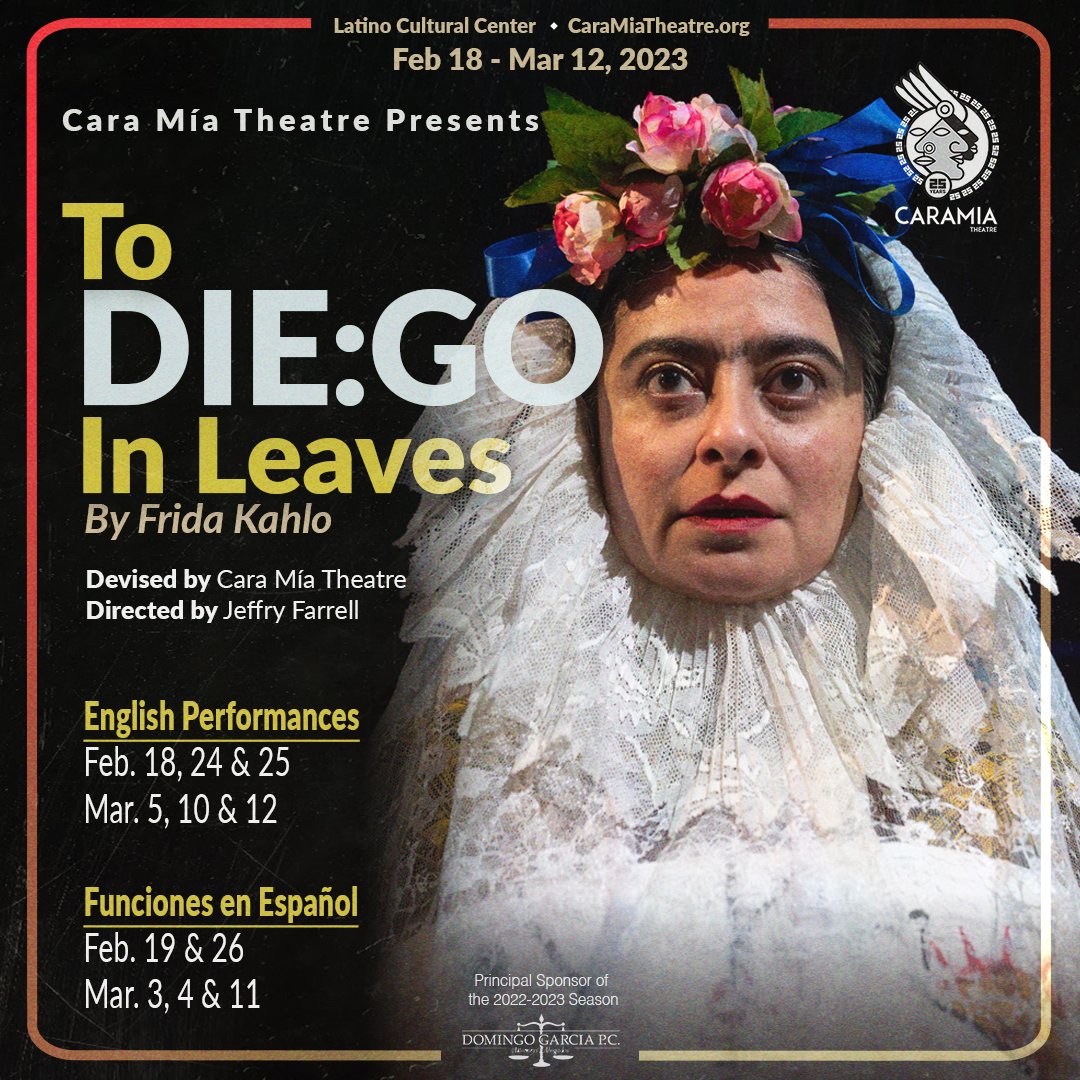To DIE:GO in Leaves @ Cara Mia Theatre
Photos by Ben Torres
—Teresa Marrero
To DIE:GO in Leaves by Frida Kahlo is a collectively devised work based on the life and art of the well-known Mexican painter Frida Kahlo. I saw the performance in Spanish at Cara Mia Theatre, at the request of one of the company members, who knows I am bilingual. (English- and Spanish-language shows alternate on the schedule.) The script was created by Cara Mia as a company: co-creators include Maryam Obaidullah Baig, Justin Brumit, Jeffry Farrell, Julian Guevara, David Lozano (Cara Mia’s artistic director), and Alana Libertad Macias—with a Spanish translation by Frida Espinosa Müller.
Percussion instruments and original music played by Kweku Codrington set the dream-like mood prior to the beginning of the action. Frida Kahlo (embodied by Espinosa Müller in the Spanish-language performances, and Obaidullah Baig, reprising her 2004 performance, in the English version) begins by intoning in slow, poetic cadence the meaning of the title, making an analogy between the leaves of a tree, which represent both life and death, and the leaves of a book (hojas in Spanish, a word with dual meaning, of tree leaves and book pages.)
“Yo estoy en un lugar entre las hojas y la muerte,” she says. (“I am at a place between the leaves and death.”)
She goes on to clarify that love, el amor, and not la pintura (painting) governs with its primacy. Thus, the poetic narrative and images unfold based upon two aspects of Kahlo’s life: her tumultuous relationship with husband and fellow artist Diego Rivera, and the series of physical ailments that shaped her life, from polio at a tender age (her right foot was left weak, and it eventually was amputated) to the well-known bus accident (Kahlo was a passenger) in which a metal rod pierced her left hip, causing chronic pain and prompting three spontaneous abortions later in her life. One has a to have a sturdy stomach and hardened feelings not to bleed internally for the extreme pain this artist suffered.
Director (and co-writer) Jeffry Ferrell, who also directed the first version of this piece some twenty years ago, states in program notes that “we created the work based in the bodies and movements of the actors,…[From selected] sketches and improvs, we identified moments that revealed authentic and immediate meaning.” As such, this piece is structured with images created by the actors, and by the few yet pivotal props onstage. I went with someone whose Spanish is not native; he said he enjoyed the open-ended feel of the production, which allowed him to connect visually with the piece and evoke his own mental images and memories.
There is a structured order based on selected moments in Kahlo’s life, and on dates related to the devolution of her physical condition and her relationship with her beloved Cara de Sapo (Toad Face, as she calls Rivera in the play). These images are accompanied by a flawless sense of rhythm created by Codrington.
One does not have to know perfect Spanish to connect with To DIE:GO in Leaves: emotions and events are made clear, and it might be an experience for English speakers to attend an in-Spanish performance—you have that option. The ensemble includes: Alysha Lynette Gonzalez, Danny Lovelle, Lozano (who plays the puppet in Frida’s imagination), Osmar Martinez, Bismark Quintanilla, and Sorany Gutierrez (understudy). Costume design is by Steven Smith (with assistance from Nicholas Lafleur), lighting by Aaron Johansen, and masks, properties, and corset design by Espinosa Müller.
There is one caveat that must be mentioned when immersing oneself into Kahlo´s life. The impression her biography by Alejandro Gómez Arias gives us is that she was mainly a wife to Rivera, whose sexual escapades are mentioned often, with no indication of Kahlo´s own rather expansive sexuality. Kahlo was sentimentally and sexually involved with both men and women, including American photographer Nick Murray, the Russian revolutionary Leon Trotsky, Costa Rican singer Chavela Vargas, Japanese sculptor Isamu Noguchi, and Jacqueline Lamba, a houseguest of Kahlo and Rivera. The inclusion of her open sexuality would provide an updated version of this artist´s life and a welcome diversion from the heterosexual dominant model.
Teresa Marrero, Ph.D. is Professor of Latin American and Latiné Theater and Culture in the Spanish Department at the University of North Texas.
WHEN: Through March 12
WHERE: Latino Cultural Center, 2600 Live Oak St., Dallas (Deep Ellum area)
WEB: caramiatheatre.org



